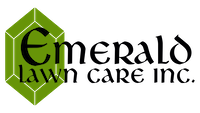Lawn Care Tips
Get Your Free Lawn Care Quote Now!
Emerald Lawn Care wants your lawn, trees, and shrubs to be healthy, lush, and beautiful. There are many things we can do to care for your landscape but there are also a few very important things you can do to ensure the best possible result.
The University of Illinois Extension – College of Agriculture, Consumer and Environmental Sciences suggests the following six items to promote maximum lawn health:
Proper Mowing Height
You may want to cut shorter to minimize the frequency of mowing but this is not a good idea. Turf that is too short may develop inadequate roots which can make it sparse and more susceptible to turf diseases. During the heat of summer, it is even more important to leave the grass a little longer. During spring and fall you can cut the grass down to 2 inches but during summer it should be a minimum of 2 ½” to 3” tall. We recommend a height of 3 ½”.

The One-Third Rule
Never remove more than one-third of the grass plant in a single cutting. If you cut more that that, you risk removing all the leaves from the grass stem, leaving only the stem which makes it difficult for the grass plant to thrive.

Sharpen That Blade!
Dull blades tear the grass blade, leaving it ragged. This will mean a less attractive lawn because the tip of each blade will brown, giving the turf a brown appearance. More importantly, it causes the blade to lose more moisture and also makes it more susceptible to disease.

Water
Practice good watering habits to maintain a healthy lawn. Water 1.5″ per week during dry periods, especially in July and August. Water deeply and infrequently; watering 2 times per week (.75″ each time) is ideal. Never water in the evening – this invites disease activity. The best time to water is between 5am and 10am.

Fertilization
We hope you will allow us to do this for you but here is some interesting information if you chose to do it yourself. The best time to fertilize (in descending order) in Northern Illinois (cool season grasses like blue grass, rye grass, and fescue) is early September, followed by early May. Third applications should be late fall and a fourth application, if desired, can be made in mid-June. The use of slow release fertilizers allows application any time, even in the middle of summer.

Thatch/Core Aeration
Using a mulching mower at regular intervals will generally not cause excess build-up of thatch (more than ½”). During spring and fall when grass grows rapidly, it might be preferable to bag some clippings if the lawn grew too long between mowings. If you are concerned about excess thatch, we recommend core aeration rather than power raking. Core aeration reduces compaction and is best done in the fall prior to seeding. We highly recommend our liquid aeration treatment over core aeration. Spring is also acceptable but may encourage weed germination. Power raking will remove thatch but it also removes many good grass plants too and doesn’t help with compaction. Important: Companies offering low priced core aeration generally use less effective equipment and try to do the job quickly to get onto the next one. The goal of core aeration should be to get as many plugs in your yard as possible. But you can eliminate this step altogether with liquid aeration.

Finally, we would recommend you take a few minutes each month to survey your property for insects, disease, weed problems, or other issues. Please call us to come out and look at anything you find. We are happy to provide this service free of charge.
The above information can be found in the Illinois Pesticide Application Training Manual 39-1 “Turfgrass”, pages 5 and 6. The added commentary is courtesy of the turf professionals at Emerald Lawn Care Inc.
Get your free lawn care analysis today! Please call or text us at 847.392.7097
or
